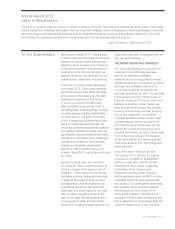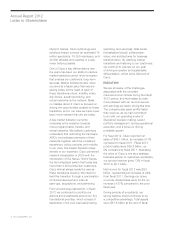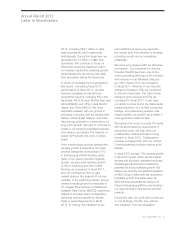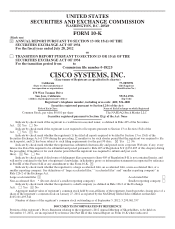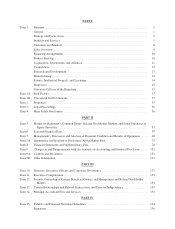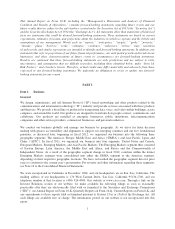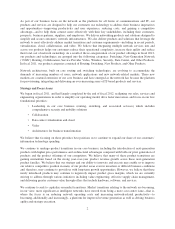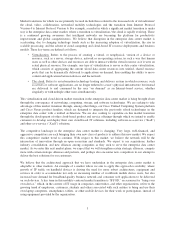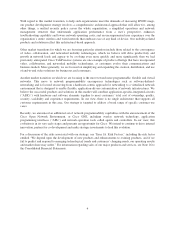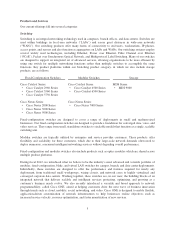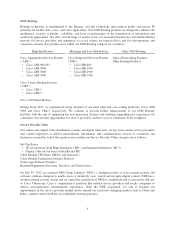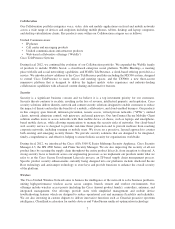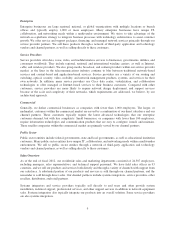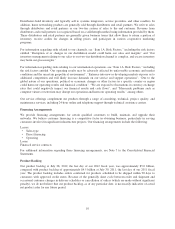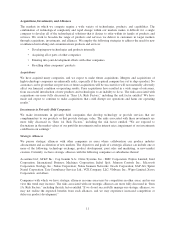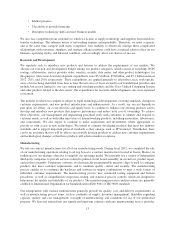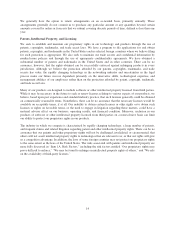Cisco 2012 Annual Report Download - page 12
Download and view the complete annual report
Please find page 12 of the 2012 Cisco annual report below. You can navigate through the pages in the report by either clicking on the pages listed below, or by using the keyword search tool below to find specific information within the annual report.With regard to this market transition, to help such organizations meet the demands of increasing BYOD usage,
our product development strategy involves a comprehensive architectural approach that will allow for, among
other things, a unified security policy across the whole organization; a simplified operations and network
management structure that understands application performance from a user’s perspective, enhances
troubleshooting capability and lowers network operating costs; and an uncompromised user experience over the
organization’s entire wireless and wired network that embraces use of any kind of device. Our mobility-related
products and solutions reflect this architectural-based approach.
Other market transitions for which we are focusing particular attention include those related to the convergence
of video, collaboration, and networked mobility technologies, which we believe will drive productivity and
growth in network loads and appear to be evolving even more quickly and more significantly than we had
previously anticipated. Cisco TelePresence systems are one example of product offerings that have incorporated
video, collaboration, and networked mobility technologies, as customers evolve their communications and
business models. More generally, we are focused on simplifying and expanding the creation, distribution, and use
of end-to-end video solutions for businesses and consumers.
Another market transition on which we are focusing is the move toward more programmable, flexible and virtual
networks. This move to network programmability encompasses technologies such as software-defined-
networking and is focused on moving from a hardware-centric approach for networking to a virtualized network
environment that is designed to enable flexible, application-driven customization of network infrastructures. We
believe the successful products and solutions in this market will combine application-specific-integrated-circuits
(“ASICs”) with hardware and software elements together to meet customers’ total cost of ownership, quality,
security, scalability and experience requirements. In our view, there is no single architecture that supports all
customer requirements in this area. Our strategy is targeted to address a broad range of specific customer use
cases.
Recently, we announced an additional set of network programmability capabilities with the announcement of the
Cisco Open Network Environment, or Cisco ONE, including overlay network technology, application
programming interfaces (“APIs”) and network-operation tools called agents and controllers. In our view, this
evolution is in its very early stages and presents an opportunity for Cisco. We intend to continue to drive internal
innovation, partner for co-development and make strategic investments to lead this evolution.
For a discussion of the risks associated with our strategy, see “Item 1A. Risk Factors,” including the risk factor
entitled “We depend upon the development of new products and enhancements to existing products, and if we
fail to predict and respond to emerging technological trends and customers’ changing needs, our operating results
and market share may suffer.” For information regarding sales of our major products and services, see Note 16 to
the Consolidated Financial Statements.
4



